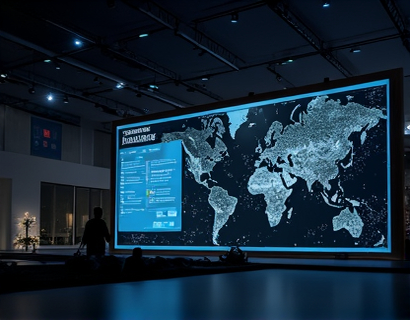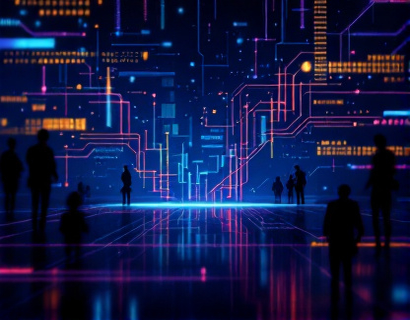Next-Gen QR Code Technology: Elevating Business and Social Media Engagement for Modern Enterprises
In the rapidly evolving digital landscape, businesses and social media managers are constantly seeking innovative solutions to enhance engagement and streamline interactions with their audience. One such technology that has emerged as a game-changer is next-generation QR code technology. This advanced form of QR codes is not just an improvement over the traditional version but a complete reimagining designed to meet the demands of modern digital engagement. These next-gen QR codes offer customizable and intuitive tools that significantly enhance information sharing and boost customer interaction, making them essential for brands looking to elevate their digital presence and foster deeper connections with their audience.
The evolution of QR codes from simple black and white squares to sophisticated, multi-functional tools reflects the broader trends in digital technology. Traditional QR codes have been widely used for tasks such as product information, coupon redemption, and website linking. However, they often fall short in terms of user experience and functionality. Next-gen QR codes address these limitations by incorporating advanced features that cater to the complex needs of today's consumers and businesses. These codes can store and deliver a wealth of information, interact with various platforms, and provide a seamless user experience, all while maintaining the simplicity and accessibility that QR codes are known for.
Enhanced Information Storage and Delivery
One of the most significant advancements in next-gen QR codes is their increased capacity for information storage. Unlike traditional QR codes, which are limited to a few hundred characters, next-gen versions can hold thousands of characters of data. This expanded capacity allows businesses to include detailed information such as comprehensive product descriptions, extensive FAQs, and even multimedia content like videos and audio clips. For instance, a company can embed a next-gen QR code on a product package that, when scanned, not only provides basic product information but also offers a 360-degree view of the product, user reviews, and a detailed instructional video.
Moreover, the ability to dynamically update the content linked to a QR code without reprinting it is a game-changer. Businesses can regularly refresh the information, promotions, or links without the need for physical changes to the QR code itself. This flexibility ensures that the information remains current and relevant, enhancing the overall user experience and keeping the audience engaged over time.
Customization and Brand Integration
Customization is another key feature of next-gen QR codes. These advanced codes can be tailored to match a brand's visual identity, including logos, colors, and design elements. This level of personalization not only makes the QR codes more visually appealing but also reinforces brand recognition and consistency across various touchpoints. For example, a luxury fashion brand can design QR codes that reflect its elegant and sophisticated aesthetic, ensuring that every interaction with the code aligns with the brand's image and values.
Furthermore, next-gen QR codes can be integrated into various marketing materials and physical environments. They can be printed on business cards, product labels, billboards, and even interior design elements. This versatility allows businesses to create immersive and interactive experiences that engage customers in multiple ways. For instance, a retail store can place next-gen QR codes on product displays that, when scanned, provide augmented reality (AR) experiences, offering customers a deeper and more engaging look at the products.
Seamless Integration with Digital Platforms
The seamless integration of next-gen QR codes with digital platforms is a critical aspect of their functionality. These codes can be easily linked to social media profiles, websites, and other online services, facilitating a smooth transition from the physical world to the digital realm. This integration enhances the overall customer journey by providing a cohesive and connected experience. For example, a QR code on a flyer can direct users to a landing page on a company's website, where they can find more detailed information, sign up for newsletters, or make purchases.
Additionally, next-gen QR codes can be used to track user interactions and gather valuable data. By incorporating tracking capabilities, businesses can monitor how many times a QR code is scanned, where it is used, and what actions users take after scanning. This data can be invaluable for understanding customer behavior, optimizing marketing strategies, and improving overall engagement. For instance, a brand can use the insights gained from QR code scans to identify which promotions are most effective and adjust their campaigns accordingly.
Enhanced User Experience and Interaction
The user experience provided by next-gen QR codes is significantly enhanced compared to their traditional counterparts. The quick and accurate scanning process, combined with the rich content delivery, ensures that users have a positive and efficient interaction. The ability to access a wealth of information with a single scan reduces friction and increases the likelihood of user engagement. For example, at a trade show, attendees can scan a next-gen QR code on a booth display to instantly access a detailed brochure, watch a product demo video, and even schedule a follow-up meeting with the company representatives.
Moreover, next-gen QR codes can be designed to interact with mobile apps, providing a more interactive and personalized experience. For instance, a fitness brand can create a QR code that, when scanned, opens a dedicated app feature offering personalized workout plans based on the user's scanned information. This level of interactivity not only enhances user engagement but also fosters a deeper connection between the brand and its audience.
Security and Trust
Security is a paramount concern in today's digital landscape, and next-gen QR codes address this by incorporating advanced security features. These codes can include encryption and authentication mechanisms to ensure that the information they link to is secure and trustworthy. This is particularly important for businesses that handle sensitive data or transactions. By using next-gen QR codes, companies can provide a secure scanning experience that builds trust with their customers. For example, a financial institution can use encrypted QR codes for mobile banking apps, ensuring that user data is protected during transactions.
Additionally, the ability to verify the authenticity of a QR code adds another layer of security. Users can be assured that the code they are scanning leads to legitimate content, reducing the risk of phishing or malicious activities. This trust factor is crucial for maintaining a positive brand reputation and ensuring customer loyalty.
Environmental and Cost Efficiency
Next-gen QR codes also offer environmental and cost benefits. Traditional marketing materials such as brochures, flyers, and printed coupons require paper, ink, and physical distribution, which can be costly and environmentally taxing. In contrast, next-gen QR codes can replace these physical materials, reducing waste and lowering printing costs. For instance, a magazine can replace pages of printed coupons with QR codes, allowing readers to access the same offers digitally.
Furthermore, the digital nature of next-gen QR codes means that updates and changes can be made instantly without the need for reprinting. This efficiency not only saves resources but also ensures that the information remains up-to-date and relevant. For businesses, this means a more sustainable and cost-effective approach to marketing and customer engagement.
Case Studies and Real-World Applications
To illustrate the practical benefits of next-gen QR code technology, consider a few real-world applications. A major automobile brand implemented next-gen QR codes on its dealership lots, linking them to virtual showrooms where potential customers could view detailed specifications, watch test drive videos, and even schedule test drives online. This not only enhanced the customer experience but also reduced the workload on sales staff, allowing them to focus on providing personalized assistance.
Another example is a travel agency that used next-gen QR codes on its promotional materials. Scanning the code led users to a personalized travel planner app, where they could input their preferences and receive tailored travel recommendations. This interactive approach not only increased engagement but also resulted in higher conversion rates for the agency's services.
Conclusion
Next-gen QR code technology represents a significant leap forward in digital engagement for modern enterprises. With their enhanced information storage, customizable design, seamless digital integration, improved user experience, robust security, and cost efficiency, these codes offer a comprehensive solution for businesses looking to enhance their digital presence and connect more effectively with their audience. As the digital landscape continues to evolve, embracing next-gen QR code technology will be essential for staying competitive and relevant in the market.










































